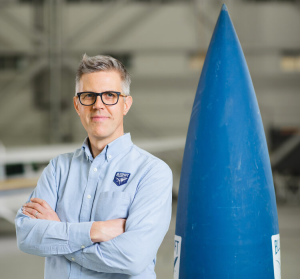
Founder & CEO
bluShift Aerospace
1. How does bluShift maintain sustainable practices through rocket manufacturing?
We have embraced sustainability since our inception when we discovered the principle substance for our non-toxic, nearly carbon neutral biofuel on my brother’s farm in 2014. Our company was founded with the belief that the future space transportation will need to embrace more Earth-friendly propellants.
On a testing and manufacturing front we are operating at Brunswick Landing which is largely powered by renewable energy. Even our test site is powered by solar panels, as it has been for the last several years. Our future launch site will also operate with solar power.
We plan to recover nearly all of our rockets after each launch, refurbish and relaunch as opposed to dumping the rockets into the ocean, which is still commonplace even today. We believe that this not only makes environmental sense but also economic.
2. What different models of rockets does bluShift manufacture?
There will be two: one that goes up and down from space for research, Starless Rogue, and the one that will take commercial nanosatellites into orbit around Earth.
We’re working on developing our first all-the-way-to-space, fully reusable suborbital rocket, Starless Rogue, right now. The rocket will have just one of our biofuel powered MAREVL™ engines and will carry primarily scientific experiments up to space and then be recovered safely back on Earth less than a half hour later. Shortly after our first commercial launches of Starless Rogue we’ll begin development and testing of our orbital launch vehicle, Red Dwarf. This two stage rocket will use 8 of our engines, be 80% reusable and carry up to 100kg of tiny, shoebox sized satellites to orbit.
Overall companies will realize operational efficiencies (resources focused on business development vs. managing infrastructure), reliability (e.g., deployments in multiple regions for disaster recovery), performance (e.g., global deployment in minutes), and cost optimization (e.g., on-demand pricing/reserved pricing)
3. BluShift launched the world’s first biofuel powered rocket. How will this impact the future of space travel and what does it mean for Maine?
In the weeks and months after we made history by launching the biofuel powered commercial rocket we saw the conversation shift within the space launch industry to question why the larger rocket companies weren’t using more Earth-friendly fuels. We believe our small launch had something to do with influencing the pressures on our industry to be more Earth-responsible.
With the global media coverage of the launch and our continued rocket engine development, we’re putting Maine on the New Space industry map. Nearly every day we get people submitting interests to come work for us from across the country. Just a year ago, most people wouldn’t have even considered Maine as a source of pursuing an inspiring career in New Space. We’re excited to grow our team in the near future.
4. What resources, partners, and companies have been helpful to bluShift as it has continued to grow?
By far our biggest key partners have been MTI, Maine Technology Institute, and MRRA, the Midcoast Regional Redevelopment Authority. Both organizations have been remarkable in their efforts to lean-in hard and be forward-thinking in their support and advancement of entrepreneurial companies from nascent high tech sectors. By comparison, most other resources in Maine focus on supporting and carrying-on heritage industries within our state and blinders on with regards to how important it is to diversify our economy.
Also critical to our growth has been our crowd equity funding campaign on Wefunder.com. It has raised nearly $1M to fund the development of our full-sized, biofuel powered MAREVL™ engine that will power all of our rockets and launch services to come. This round of funding has been like a ‘Friends & Family’ round on steroids, where not only actual friends and family have invested in launching sustainable aerospace, but also people from all over the world. To date, we have over 1000 investors, investing from one hundred dollars to tens of thousands. The campaign has been energizing for our entire team.
5. What are your plans for growing bluShift in the next few years?
There’s going to be a huge rise in nano satellite launches and bluShift will make these greener and more earth responsible.
In the next two years we will be ramping up our Earth-Friendlier commercial suborbital launch services for researchers across the globe. We’ll be starting a traditional seed round of funding and then move on to a Series A next year. We’ll grow our team to over 100 innovative individuals to support not only our research and development, but also manufacturing, launch logistics and customer-facing services.
Powered by both our launch revenues and an additional round of funding we will be launching tiny satellites off the coast of Maine within 5 years. This service will target companies that want to provide all of us with high-speed internet, cell phone and Earth-imaging services no matter how rurally located we are on the globe. Our team will grow to an estimated 200+ strong, with the bulk of our team focused on manufacturing right here in Maine.
bluShift’s vision for the future is possible thanks in large part to the resources that have been intentionally fostered in our state, talented individuals that have grown up here and moved here, and the geographic advantage that Maine uniquely provides to put these tiny satellites in a highly desired orbit.
We are excited to make the future of aerospace continue to have the words ‘Made in Maine’.
By submitting this form, you are consenting to receive marketing emails from: . You can revoke your consent to receive emails at any time by using the SafeUnsubscribe® link, found at the bottom of every email. Emails are serviced by Constant Contact
Last modified: March 7, 2022






